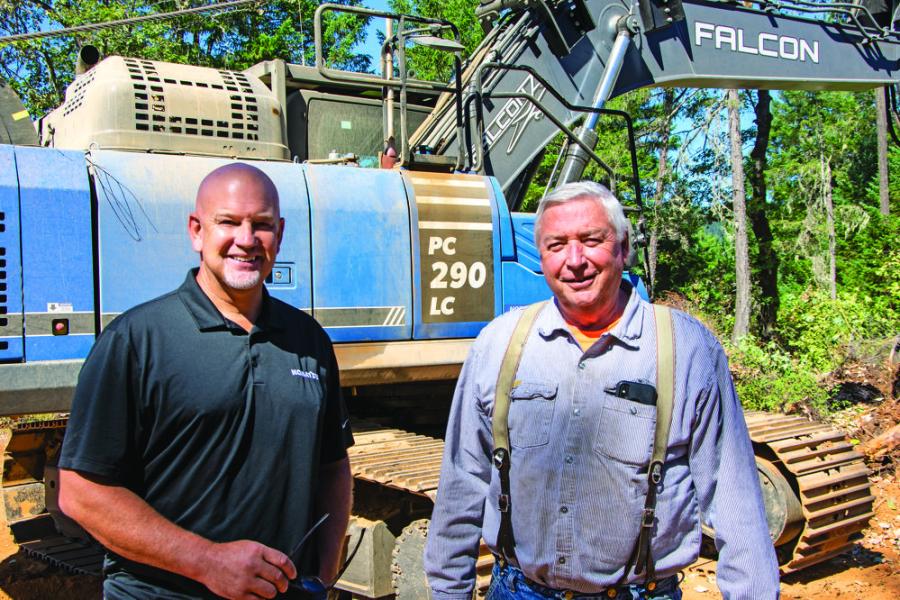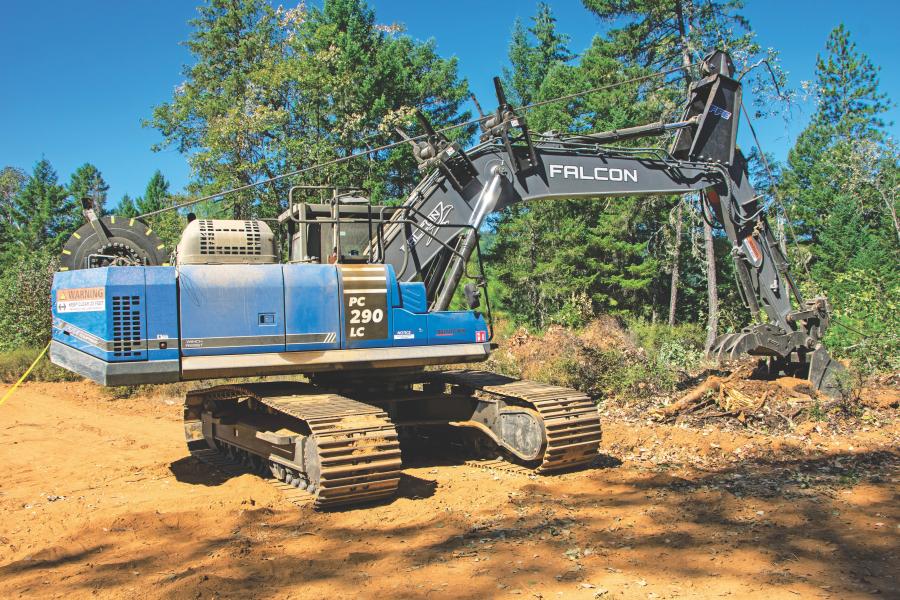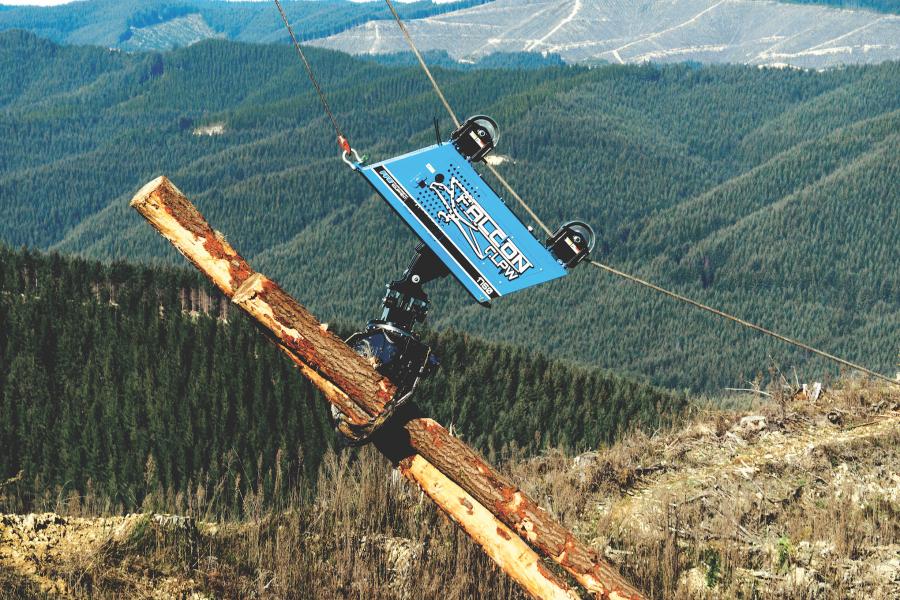Modern Machinery Territory Manager Ed James (L) and Dancer Logging Inc. Owner Pete Dancer Sr. The Komatsu PC290 excavator that Modern Machinery equipped with a Falcon Winch Assist helps Dancer Logging Inc. perform logging on steep terrain and is used as the “top” or “uphill” machine.
Last year marked the 25th anniversary of Dancer Logging Inc.'s reincarnation in Oregon.
"Like a lot of loggers in this area, the presence of the spotted owl took its toll on us in the late 1980s," Pete Dancer Sr. recalled. "I finished the last contract I had and moved three sites to New Zealand in 1990. As things settled here, I started looking to come back. With kids in junior high and high school and aging parents, we felt it was a necessity."
He did not have to completely start from scratch and work in the woods by himself like he did in 1975, when Pete and his wife, Bonnie, originally founded Dancer Logging. This time around, he bought a logging site from a lumber company that came with equipment and employees.
"We slowly grew and as the boys got older, they joined the business," said Dancer. "We now have five sites and more than 50 employees, which is roughly equivalent to what I had in the 1980s. We cover a couple of hours in each direction from our home base in Camas Valley."
Dancer's three sons, Pete Jr., Scott and Eric, are now part owners of Dancer Logging Inc. Eric and Pete Jr. run sites, while Scott dispatches the company's fleet of log trucks and moves equipment. Pete Jr.'s son, Bradley, joined the company and runs a site as well.
"Our projects are primarily clear cuts on private land," Dancer explained. "We do thinning on rare occasions. Our logs go to a lot of places for a wide variety of uses. The main species we harvest is Douglas fir, followed by hemlock, white fir and cedar. We also deal with several hardwoods. In total, I would say we handle about 12 million board feet per year."
Safer, More Cost-Effective Logging
Dancer Logging recently purchased a tether system that consists of a modified low-hour, previously-used Komatsu PC290 excavator that Modern Machinery equipped with a Falcon Winch Assist. The set-up is primarily for logging on steep terrain and is used as the "top" or "uphill" machine. It sits stationary with no operator and the bucket is dug into the ground for added stability.
A hydraulic winch is mounted on the back of the PC290, which gives it approximately the same operating weight as a traditional excavator. The winch houses about 1,640 ft. of 1 1/8-in. swaged rope with nearly 80 tons of breaking strength. It runs through rollers on the main boom, has a tension monitor where the boom and arm meet that senses the load and an optional quick hitch near the bucket.
The end of the line is attached to the "downhill" machine's undercarriage, which in Dancer Logging's case is typically an 85,000-lbs. (or more) harvester that operators use to cut timber. A control box and antennas are mounted inside and outside the cab of the PC290 for communication with the "downhill" machine.
Operator Brandon Dean uses the winch to move uphill and downhill, controlling it remotely with foot pedals. Winch mode, tension settings, manual pay out or wind in rope and remote emergency stop are controlled via the joystick in the harvester. A control screen displays rope tension, length of rope payed out and additional important information.
"It's all mechanized, so there is no need for guys on the ground which increases safety," said Dean. "I can cut as much in a day as three cutters, and with the steep-slope capabilities we can work in winter conditions where we could not before. The Winch Assist has plenty of power to pull the harvester uphill and over a stump if it gets hung up, and I can control the speed."
Dean added, "Another nice feature is versatility. If I need to clear a spot, dig or do some road building, I can use the PC290, so it's more than just a unit that sits still and holds the ‘downhill' machine."
Modern Machinery Territory Manager Ed James helped Dancer Logging with a rental purchase option so that it could put the PC290 and Falcon Winch Assist combination to the test.
"We decided to use it on three projects, and if it worked out as anticipated, we would buy it," said Dancer. "We officially put it into our fleet late last year, so the results speak for themselves. It proved to be a safe alternative to putting guys on the ground to hand fell trees, and it was really the only cost-effective way to do those jobs with the steep ground.
"I have to give Ed and Modern a lot of credit for getting the system set up and for training us on how to use it properly," Dancer added. "This was our first time dealing with Modern and we were very impressed. We appreciate everything they have done."
Dancer Logging recently added a Falcon Claw 1750, which runs on cables from a yarder and is controlled remotely by joystick. The unit has a high-quality, waterproof camera with infrared for low light and poor visibility operation, and an in-built light enables the operator to work day or night. An LCD display gives the operator clear visibility and real-time information from the video feed, including GPS, distance from the grapple to the yarder, and altitude from the landing. The Falcon Claw removes the need for a downhill crew and a poleman at the top of the skid, increasing safety and cost-effectiveness.
Anticipating Vacation Time
After more than 45 years in the woods, Dancer is ready to take a step back. He will turn 70 later this year and is looking forward to vacationing more with his wife, Bonnie, who has done bookkeeping for Dancer Logging through all of its incarnations.
"I'm happy with where the business is," he said. "The boys have helped tremendously in building it and they will do a great job running it. I'll work in a consulting role. Other than that, I don't see a lot of change. I think Dancer Logging will continue to do what it's always done — provide good service and quality logs to its customers."
(This story was reprinted from Modern Update Magazine March 2022 Issue.)
This story also appears on Forestry Equipment Guide.
Today's top stories


















